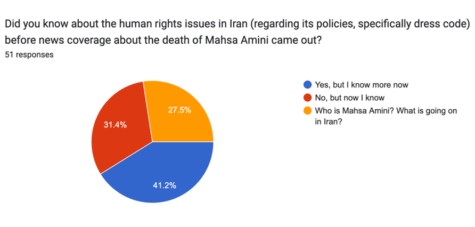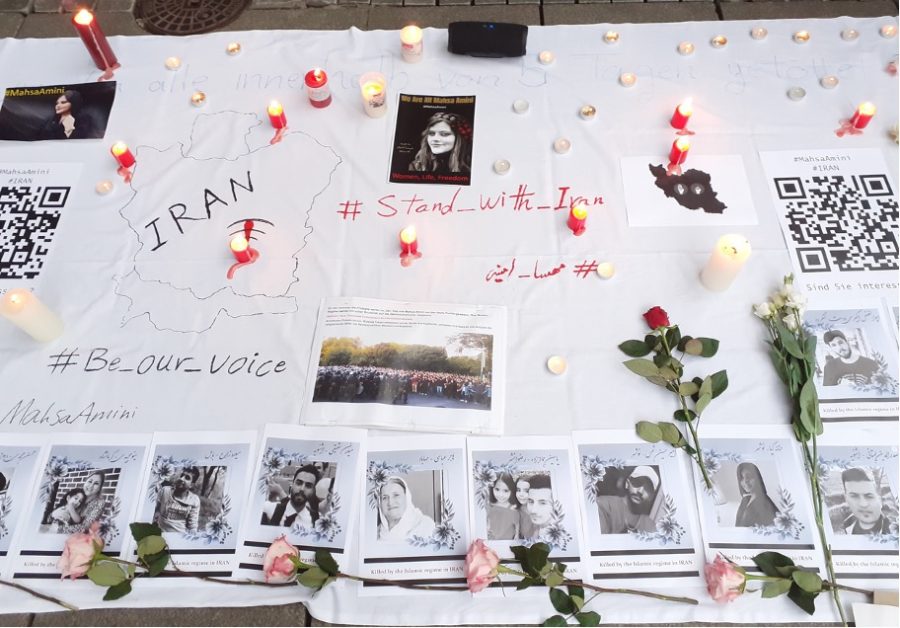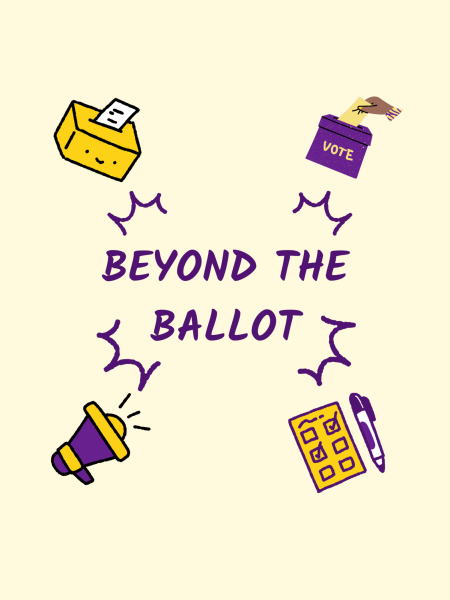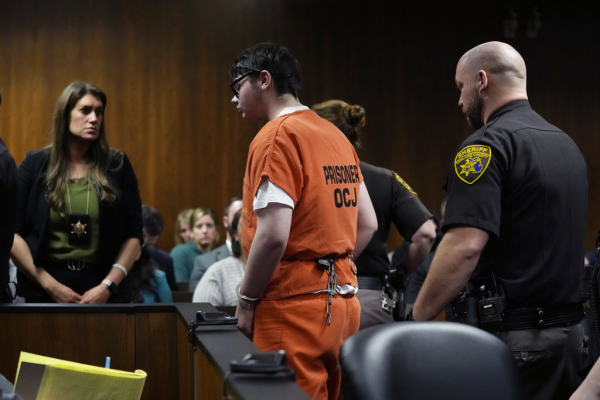Mahsa Amini’s death: The state of Iran and its online discussion
Her death led to protests and activism throughout the Islamic Republic.
During a visit to Northern Tehran from Saqez, 22-year-old Mahsa Amini was arrested by the morality police for incorrectly wearing her headscarf, violating the Iranian dress code. On Sept. 13, Amini was detained outside of a metro station and was taken to a detention center to be trained on Iranian laws and how to properly wear her headscarf in public.
Three days after her arrest, Amini died in a Tehran hospital. According to the Iranian government, Amini collapsed from a heart attack while in custody and was taken to the hospital immediately, but many claim that the Iranian government is not telling the whole truth.
Witnesses of Amini’s arrest claim that she was beaten by the morality police during her transportation to the detention center. Amini’s family claims that she was in perfect health, leaving people questioning what truly induced her coma.
Her death led to protests and activism throughout the Islamic Republic. People around the world have been expressing their concerns and spreading information on the incident online to garner support for the Iranians risking their lives in non-compliance.
As of Oct. 4, the reported death count of Iranian protesters is 133, and 920 people are injured from their participation in the protests. Iranian women burned their hijabs and cut their hair in defiance of the modesty laws.
These protests were not anti-religion, but anti-forced religion. However, the theocratic Iranian government does not condone these open acts of disobedience. The Iranian government deployed riot police officers, security forces, and one of the forces of the Islamic Revolutionary Guard Corps known as the Basij militia to put an end to anti-government protests.
In addition to the brute force used to terminate the opposition, counter-protests have begun. While not as supported by the general public, these protests faced no resistance from the government as they are for the current establishment in Iran and defy the claims that Amini’s death was at the hands of the morality police. Protests such as these have been broadcasted throughout Iran to influence others to join.
Videos of the protests in Iran have circulated online, and others internationally expressed concern. Outside of Iran, people in Australia, Europe, and the United States have taken to the streets, and people all over the world have used their online platforms to express solidarity with Iranian protesters facing the dangers of their defiance.
The Islamic Republic of Iran fears international interference and escalation of anti-government movements, so one of the largest internet restrictions has been implemented. Internet restrictions from four in the afternoon to midnight have been the strictest being that they are the typical times of protests. As a result, arrests have intensified with little media coverage.
Some Pascack Hills students responded to a form about the policies in Iran. Of the 51 students, 31.4 percent did not know about Iranian policies or Mahsa Amini before her death and 27.5 percent still do not know about the crisis even with the intense media coverage.

Results of the survey sent out to Hills students.
The republic that Iranian subjects are currently ruled under was not always in power. Until the 1979 Iranian Revolution, the country was ruled by a secular dictatorship under the Shah.
Until 1935, Iran was Persia. During the 1930s, Reza Shah formed reforms that would be considered extremist in a different way than the Iranian policy is now. Iran was a constitutional monarchy with a nominal parliamentary system. For example, as opposed to the strict pro-Islam laws enforced by the morality police, in the 1930s, the Shah banned veils while the police were ordered to remove headscarves.
Throughout history, Iran has been subject to two very different levels of extreme. The constitutional monarchy that was led by Mohammad Reza Shah had been overthrown in 1979 when the Iranian people voted to become an Islamic republic under a new constitution that reflects theocratic-republican ideals.
Although the current Iranian government is built on revolution and defines itself as a republic, when government opposition occurs, Iranians are censored. The protests following Amini’s death were not the first, and according to the adamant reformers, will not be the last.
The current Iranian regime is notorious across the media for harassment of minorities in the name of Islam. The treatment of Iranian protesters by government officials has caught international attention throughout the years, varying from the 1999 student protests to the current Masha Amini protests.
The United Nations (U.N.) proclaimed The Universal Declaration of Human Rights in 1948 as a standard that nations should follow, for the protection of people’s universal human rights. Iran has been a member of the U.N. since 1945.
The Human Rights Council promotes, protects, and addresses violations of human rights throughout the world. Nada Al-Nashif, the United Nations Deputy High Commissioner for Human Rights and current acting High Commissioner, responded to Amini’s death publicly.
“[Her] tragic death and allegations of torture and ill-treatment must be promptly, impartially, and effectively investigated by an independent competent authority, that ensures, in particular, that her family has access to justice and truth,” she said.
The videos of women in Iran made their way to the U.N. Human Rights Office and roused support from people all over. Al-Nashif condemned the treatment of the protesters, and Iran has been called upon to respect the human right to expression and assembly.
Hills senior and Model U.N. leader Trayee Jha gave her input on how the United Nations can approach the crisis of injustice in Iran.
“I think that Iran is disobeying the Universal Declaration of Human Rights…[Mahsa Amini’s violent treatment by the Morality Police] is a clear violation of the right to security from harm…While the U.N. has condemned the actions of the Iranian government, they are unable to physically enter Iran and change their system,” she said.
The internet discussions around the topic of the Iranian government, let alone Mahsa Amini, include concern, support, and attention. As of Oct. 4, the Iranian government continues to restrict the internet from its people and denies any foul treatment of Amini.
Jha ended with more about the U.N.
“Ultimately, it is the choice of the country and its government to obey the wishes of the U.N. …the U.N. can only take military action and physically intervene in a country if all permanent members of the Security Council vote positively to do so,” she said.
Sources:
https://2017-2021.state.gov/the-islamic-republic-of-iran-a-dangerous-regime/index.html#Struggle
https://courses.lumenlearning.com/suny-hccc-worldhistory2/chapter/the-islamic-republic-of-iran/
https://time.com/6216024/iran-protests-islamic-republic-response/
https://www.aljazeera.com/news/2022/9/25/iran-organises-counter-demonstrations-as-protests-continue
https://www.npr.org/2022/09/21/1124237272/mahsa-amini-iran-women-protest-hijab-morality-police

Paige Geanopulos is a senior at Hills. She joined the Trailblazer her freshman year as a staff writer, became the editor for the In-Depth section her sophomore year, and was the editor for the School News section her junior year. This year, Geanopulos looks forward to being the publication's Editor-in-Chief and continuing to write, edit, and manage stories for the Hills community.
Fun fact: Geanopulos has gone cliff diving in Naxos, Greece!













































